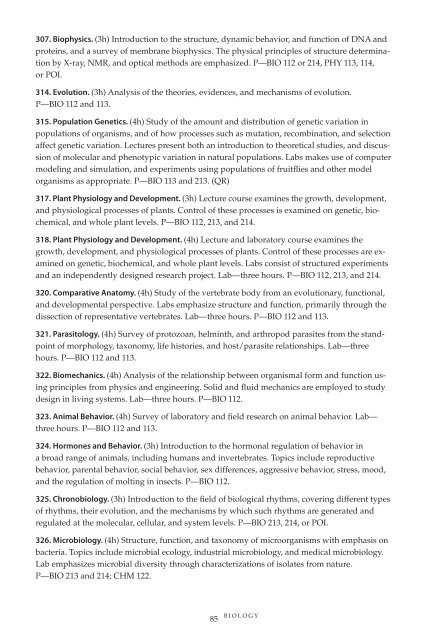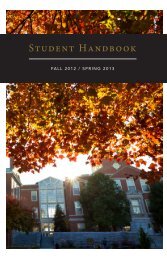theundergraduateschoo ls - Wake Forest University
theundergraduateschoo ls - Wake Forest University
theundergraduateschoo ls - Wake Forest University
You also want an ePaper? Increase the reach of your titles
YUMPU automatically turns print PDFs into web optimized ePapers that Google loves.
307. Biophysics. (3h) Introduction to the structure, dynamic behavior, and function of DNA and<br />
proteins, and a survey of membrane biophysics. The physical principles of structure determination<br />
by X-ray, NMR, and optical methods are emphasized. P—BIO 112 or 214, PHY 113, 114,<br />
or POI.<br />
314. Evolution. (3h) Analysis of the theories, evidences, and mechanisms of evolution.<br />
P—BIO 112 and 113.<br />
315. Population Genetics. (4h) Study of the amount and distribution of genetic variation in<br />
populations of organisms, and of how processes such as mutation, recombination, and selection<br />
affect genetic variation. Lectures present both an introduction to theoretical studies, and discussion<br />
of molecular and phenotypic variation in natural populations. Labs makes use of computer<br />
modeling and simulation, and experiments using populations of fruitflies and other model<br />
organisms as appropriate. P—BIO 113 and 213. (QR)<br />
317. Plant Physiology and Development. (3h) Lecture course examines the growth, development,<br />
and physiological processes of plants. Control of these processes is examined on genetic, biochemical,<br />
and whole plant leve<strong>ls</strong>. P—BIO 112, 213, and 214.<br />
318. Plant Physiology and Development. (4h) Lecture and laboratory course examines the<br />
growth, development, and physiological processes of plants. Control of these processes are examined<br />
on genetic, biochemical, and whole plant leve<strong>ls</strong>. Labs consist of structured experiments<br />
and an independently designed research project. Lab—three hours. P—BIO 112, 213, and 214.<br />
320. Comparative Anatomy. (4h) Study of the vertebrate body from an evolutionary, functional,<br />
and developmental perspective. Labs emphasize structure and function, primarily through the<br />
dissection of representative vertebrates. Lab—three hours. P—BIO 112 and 113.<br />
321. Parasitology. (4h) Survey of protozoan, helminth, and arthropod parasites from the standpoint<br />
of morphology, taxonomy, life histories, and host/parasite relationships. Lab—three<br />
hours. P—BIO 112 and 113.<br />
322. Biomechanics. (4h) Analysis of the relationship between organismal form and function using<br />
principles from physics and engineering. Solid and fluid mechanics are employed to study<br />
design in living systems. Lab—three hours. P—BIO 112.<br />
323. Animal Behavior. (4h) Survey of laboratory and field research on animal behavior. Lab—<br />
three hours. P—BIO 112 and 113.<br />
324. Hormones and Behavior. (3h) Introduction to the hormonal regulation of behavior in<br />
a broad range of anima<strong>ls</strong>, including humans and invertebrates. Topics include reproductive<br />
behavior, parental behavior, social behavior, sex differences, aggressive behavior, stress, mood,<br />
and the regulation of molting in insects. P—BIO 112.<br />
325. Chronobiology. (3h) Introduction to the field of biological rhythms, covering different types<br />
of rhythms, their evolution, and the mechanisms by which such rhythms are generated and<br />
regulated at the molecular, cellular, and system leve<strong>ls</strong>. P—BIO 213, 214, or POI.<br />
326. Microbiology. (4h) Structure, function, and taxonomy of microorganisms with emphasis on<br />
bacteria. Topics include microbial ecology, industrial microbiology, and medical microbiology.<br />
Lab emphasizes microbial diversity through characterizations of isolates from nature.<br />
P—BIO 213 and 214; CHM 122.<br />
B I O L O G Y<br />
85






